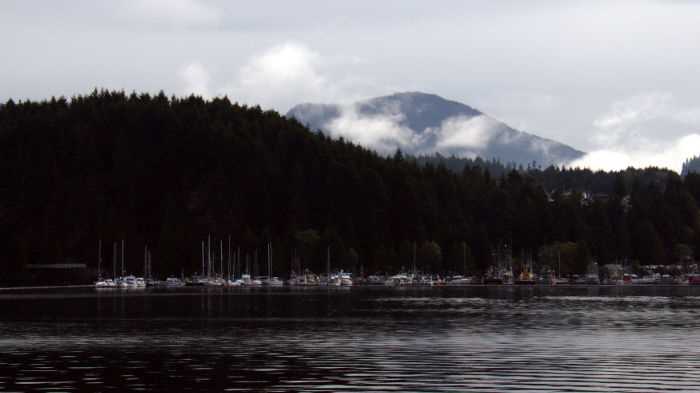We woke at 6 a.m. aboard National Geographic Sea Bird as we reached our Canadian checkpoint in Prince Rupert on the western coast of British Columbia. Canadian customs agents boarded the ship and then cleared us to set off in our expedition landing crafts to explore the town. We spent the morning and early afternoon walking about this sleepy port village, visiting the Museum of Northern British Columbia and perusing the shops, business-front murals, and cafés. Prince Rupert has a population of more than 12,000 people and is one of the deepest water ports on the western Canadian coast. The city is served by a road system, the Alaska Marine Highway, and a rail system that serves mainland Canada, delivering goods that arrive from overseas by container ship. After we departed, we cruised along the Canadian Inside Passage, watching for wildlife as cumulus clouds built up and drifted overhead, and we passed what at first glance appeared to be a barge adrift in the sound. We realized that in fact what we were seeing was a light station situated on an island in the shape of a small ship. Onto Hecate Strait and Haida Gwaii.
- Daily Expedition Reports
- 08 Sep 2019
Prince Rupert & British Columbia, 9/8/2019, National Geographic Sea Bird
- Aboard the National Geographic Sea Bird
- Alaska
Lynn Wilbur, Naturalist/Expedition Diver
Lynn is a marine biologist and underwater photographer whose passion lies in the intertidal zone. Lynn’s love of the ocean began when she was just four years old after experiencing a tide pool for the first time, and she received her first scuba cert...
Read MoreShare Report
Voyage to Alaska, British Columbia and Haida Gwaii
VIEW ITINERARYRelated Reports
5/11/2025
Read
National Geographic Sea Bird
Glacier Bay National Park
We had a phenomenal day at Glacier Bay National Park. The sun was out, as was the wildlife. The bow was the place to be. Please enjoy the dialogue of the day from the bow: Ah, Lovely Sunrise. Dall’s porpoise! Killer whales! Oo, swans! Calving center! Bald eagle on ice. Brown bear, That’s a big one. Bald eagle in nest. I wish someone would find me a marmot. Marmot at 10! Where? Do you see that crack in the rock? To the left you’ll see a tree. Now go below the tree to the round rock. 6 goats plus bonus outcast goat. Low goats on ledge, wedged in nicely. Goats, goats everywhere, and a marmot here or there. Two puffins. Nice beak action. It’s like “I Spy” out here. Low goat at 11. Oh, really low goat. Oh, yea that’s a fella. Goats looking right at us, folks, good goat face. Oh, and whale spots at 1. Oh boy, I’m exhausted. That’s ok, take it one goat at a time. There’s a spout off the point. Classic humpback. Oh, glaucous winged gulls nesting at 2. And otters! Fly by puffins! Porpoising harbor porpoise! Needless to say, we had a good time. Photo by Shannon Malone
5/10/2025
Read
National Geographic Sea Bird
Tracy Arm
As we continued our way north through Alaska, we had a favorite stop of mine in Tracy Arm-Fords Terror Wilderness. We had a rainy day, which I enjoy because we can see at higher elevations since the rain turns to snow and, in turn, the snow feeds the absorption zone of the Sawyer Glaciers. We went out in the Zodiacs and navigated around the icebergs and bergy bits, even collecting a piece for the ice melt-off challenge. Once underway out of Tracy Arm, we saw some humpback whales. One whale had an entanglement of line on its fluke. The line was causing an obvious cut to the marine mammal. The correct authorities were notified about the condition of the whale and location of the sighting. Hopefully the whale will be assisted soon and the entanglement removed. Several other humpbacks were seen shortly after, luckily no entanglements on these. They were demonstrating surface feeding behavior, with one lunge feeding and the other making bubbles to catch its prey.







